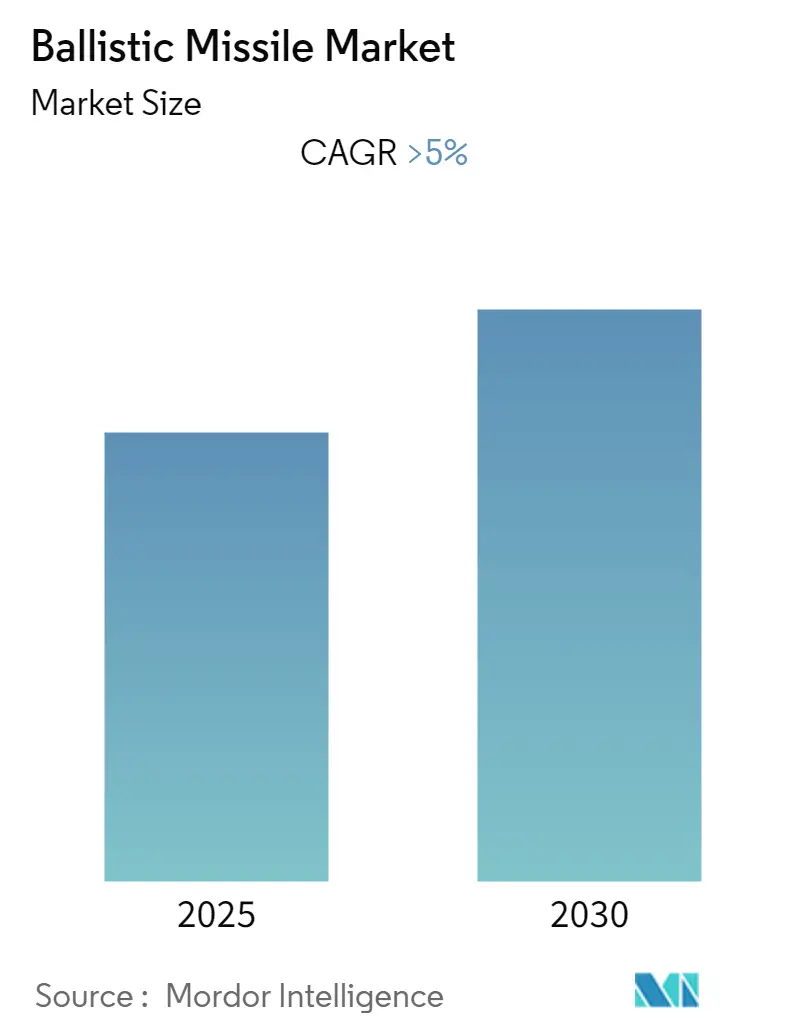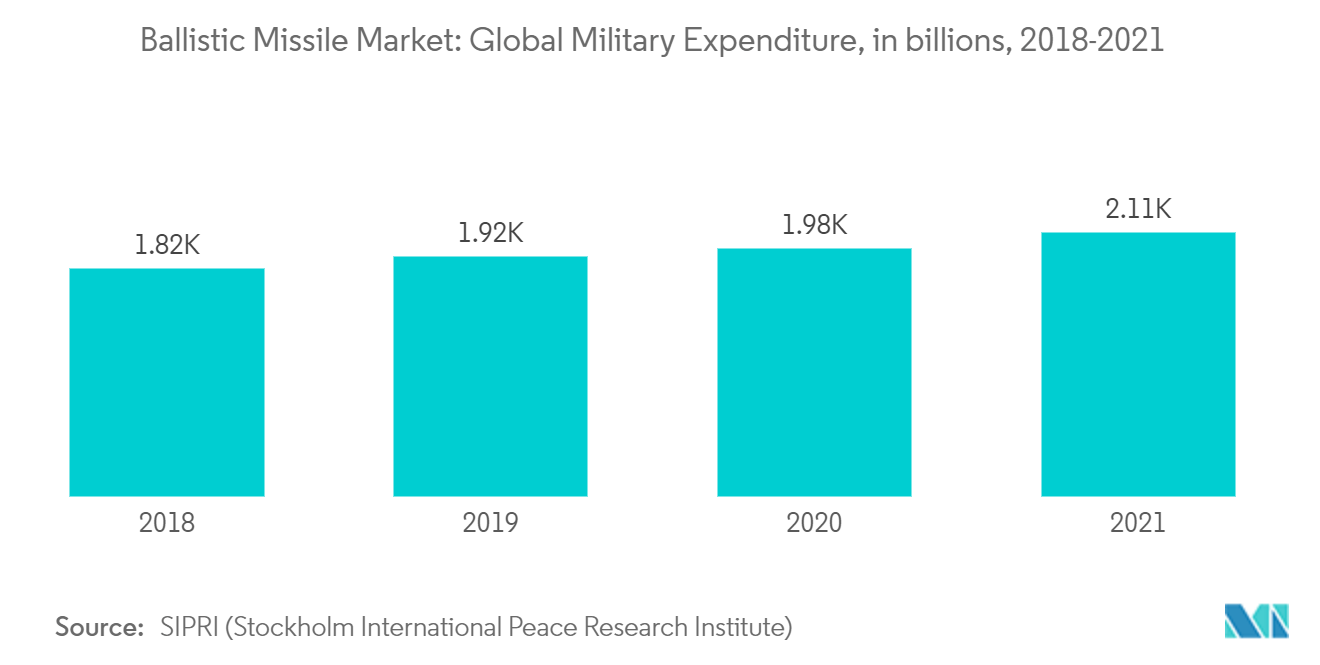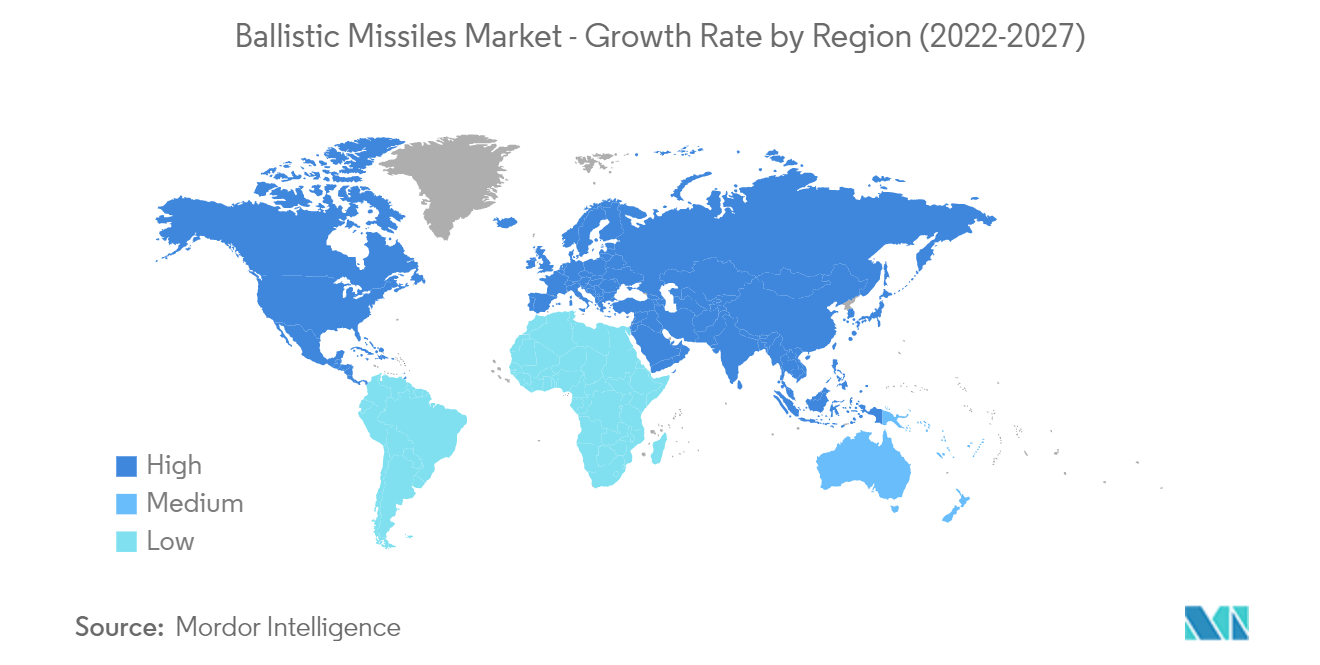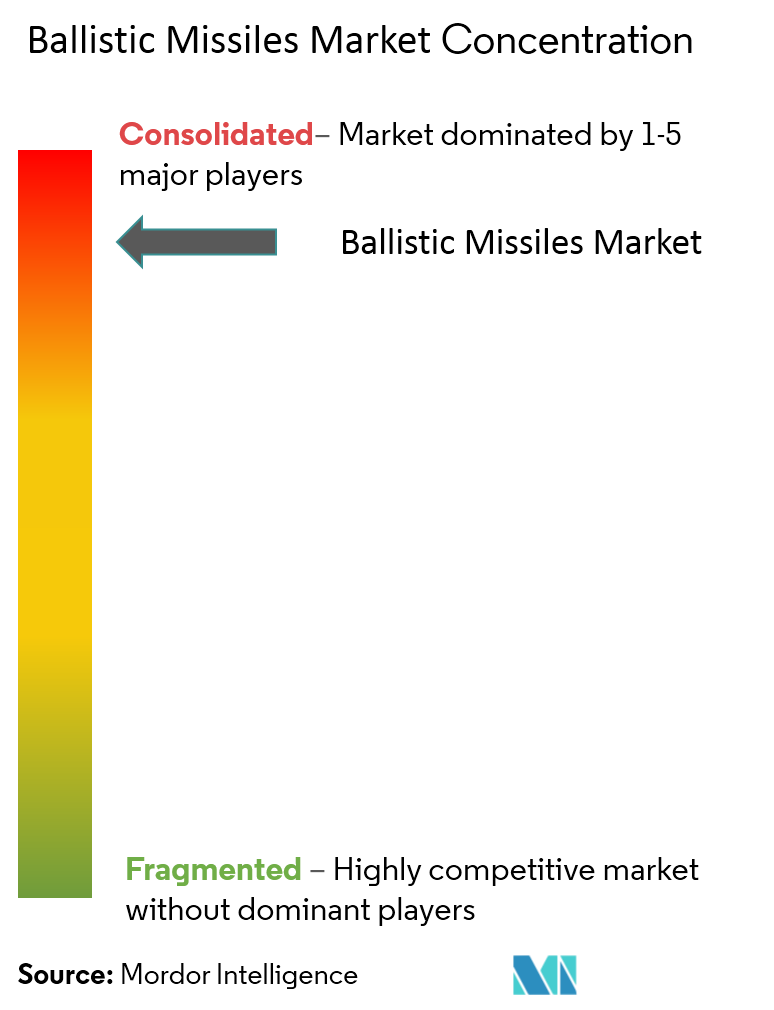Ballistic Missile Market Analysis
The Ballistic Missile Market is expected to register a CAGR of greater than 5% during the forecast period.
The COVID-19 pandemic had a moderate effect on the market because of the disruption in the supply chain in 2020. However, the market became stable within a short time and has also grown in 2021 and 2022. With the increase in the defense budgets of countries worldwide, the market is expected to grow. According to the Stockholm International Peace Research Institute (SIPRI), the global military expenditure in 2021 reached USD 2 trillion, an increase of 0.7% compared to the global military expenditure in 2020. The global military budget has been increasing every year for the past 8 years, and with tensions between the nations, the military expenditure by various nations is expected to increase, which would result in a surge in investments for the development and procurement of ballistic missiles during the forecast period. The development of nuclear ballistic missiles by the major military superpowers is expected to generate huge demand for ballistic missiles in the future.
Ballistic Missile Market Trends
Intercontinental Segment is Projected to Witness the Highest Growth During the Forecast Period
The intercontinental segment of the market is expected to record the highest CAGR during the forecast period. Due to their advantages of high accuracy at higher ranges compared to small-, medium-, and intermediate-range missiles, countries are now developing and testing new and advanced intercontinental ballistic missiles, which may drive the growth of this segment during the forecast period. For instance, the US Air Force is currently working on the LGM-35A Sentinel weapon system, an intercontinental ballistic missile system that is expected to replace the current LGM-30G Minuteman III. The contract worth USD 13.3 billion for developing this missile system was awarded to Northrop Grumman in 2020, and the project is expected to finish by 2029. The geopolitical tensions have resulted in countries investing in the market and also developing and testing new intercontinental ballistic missiles. For instance, in June 2022, Russian President Putin announced that the country's new nuclear-capable intercontinental ballistic missile, Samrat, which was launched in April 2022 from Plesetsk and successfully hit the target in the Kamchatka peninsula, which is at a distance of about 6000 km from the launch site, will be deployed by the end of 2022. Such developments are expected to supplement the growth of the market during the forecast period.
Asia-Pacific is Projected to Record the Highest Growth During the Forecast Period
Due to the tensions between the nations within the region, countries have been increasing their defense budgets to strengthen their defense capabilities, which would have a positive impact on the growth of the market. For instance, China's Ministry of Finance has announced that the country's defense spending for the year 2022 will be USD 230.16 billion, which is an increase of 7.1% from the previous year, 2021. Most of the countries that are financially and technically capable are now developing indigenous missiles in their countries rather than importing them from other nations. For instance, in September 2022, the Defense Ministry of India signed a contract with BrahMos Aerospace for the procurement of additional dual-role capable surface-to-surface BrahMos missiles under the "buy Indian" category for INR 1,700 crores. Apart from the usual geopolitical tensions, recent missile tests and firings by North Korea, which is a nuclear-armed nation, have caused more tension within the region. In October 2022, North Korea conducted its longest-range missile test over Japan. In November 2022, North Korea test-fired 22 missiles at once; one of these missiles was launched toward Ulleung Island in South Korea. Such developments are likely to fuel the growth of the ballistic missile market in the Asia-Pacific region over the forecast period.
Ballistic Missile Industry Overview
The concentration of players in the ballistic missile market is high. The prominent players in the market are BAE Systems PLC, General Dynamic Corporation, Lockheed Martin Corporation, Northrop Grumman Corporation, and The Boeing Company. Government investments in state-owned companies for the development of advanced ballistic missiles are helping the regional players increase their presence in the market. Also, partnerships between players in various fields, like propulsion systems, warhead designs, and body designs, are likely to help companies develop advanced missile systems as they share technologies with each other.
Ballistic Missile Market Leaders
-
BAE Systems PLC
-
General Dynamic Corporation
-
Northrop Grumman Corporation
-
Lockheed Martin Corporation
-
The Boeing Company
- *Disclaimer: Major Players sorted in no particular order
Ballistic Missile Market News
September 2022: The US Air Force announced that it has tested an unarmed international ballistic missile, which is equipped with three test re-entry vehicles, from the Vandenberg Space Force Base in California.
June 2022: India tested its nuclear-capable surface-to-surface intercontinental ballistic missile. It has been launched from Dr. APJ Abdul Kalam Island.
Ballistic Missile Industry Segmentation
A ballistic missile is a rocket-propelled self-guided strategic weapon system, that uses projectile motion to deliver a warhead on the target. Typically these missiles are segregated by range as short, medium, intermediate, and intercontinental ballistic missiles. Short-range ballistic missiles are missiles that have a range between about 150 km and 300 km. Medium-range ballistic missiles have a range between about 300 km and 3,500 km. Intermediate-range ballistic missiles have a range between about 3,500 km and 5,500 km. Intercontinental ballistic missiles have a range greater than 5,500 km.
The ballistic missile market is segmented by launch mode, range, and geography. By launch mode, the market is segmented into surface-to-air, air-to-surface, surface-to-surface, air-to-surface, and subsea-to-air. By range, ballistic missiles are classified into short-range, medium-range, intermediate-range, and intercontinental. By geography, the market is segmented into North America, Europe, Asia-Pacific, Middle East and Africa, and the Rest of the World. The report also covers the market sizes and forecasts across major regions. For each segment, the market sizing and forecasts are based on value (USD billion).
| Launch Mode | Surface-to-Surface | ||
| Surface-to-Air | |||
| Air-to-Surface | |||
| Air-to-Air | |||
| Subsea-to-Air | |||
| Range | Short-range | ||
| Medium-range | |||
| Intermediate-range | |||
| Intercontinental | |||
| Geography | North America | United States | |
| Canada | |||
| Europe | United Kingdom | ||
| France | |||
| Russia | |||
| Germany | |||
| Rest of Europe | |||
| Asia-Pacific | China | ||
| India | |||
| Japan | |||
| South Korea | |||
| Rest of Asia-Pacific | |||
| Middle East and Africa | UAE | ||
| Israel | |||
| Saudi Arabia | |||
| South Africa | |||
| Rest of the World | |||
Ballistic Missile Market Research FAQs
What is the current Ballistic Missile Market size?
The Ballistic Missile Market is projected to register a CAGR of greater than 5% during the forecast period (2025-2030)
Who are the key players in Ballistic Missile Market?
BAE Systems PLC, General Dynamic Corporation, Northrop Grumman Corporation, Lockheed Martin Corporation and The Boeing Company are the major companies operating in the Ballistic Missile Market.
Which is the fastest growing region in Ballistic Missile Market?
Asia Pacific is estimated to grow at the highest CAGR over the forecast period (2025-2030).
Which region has the biggest share in Ballistic Missile Market?
In 2025, the North America accounts for the largest market share in Ballistic Missile Market.
What years does this Ballistic Missile Market cover?
The report covers the Ballistic Missile Market historical market size for years: 2020, 2021, 2022, 2023 and 2024. The report also forecasts the Ballistic Missile Market size for years: 2025, 2026, 2027, 2028, 2029 and 2030.
Our Best Selling Reports
Ballistic Missile Industry Report
Statistics for the 2025 Ballistic Missile market share, size and revenue growth rate, created by Mordor Intelligence™ Industry Reports. Ballistic Missile analysis includes a market forecast outlook for 2025 to 2030 and historical overview. Get a sample of this industry analysis as a free report PDF download.







